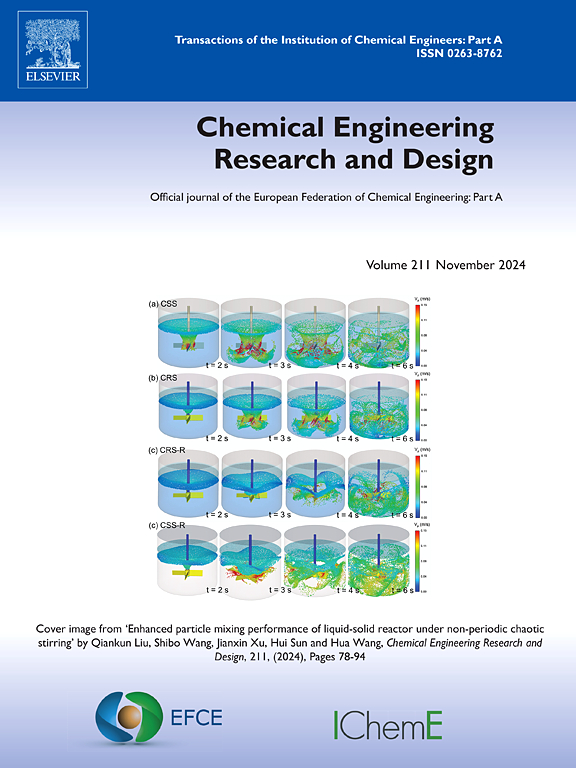Coal char-CO2 gasification reactivity and kinetics characteristics for varying char particle sizes
IF 3.7
3区 工程技术
Q2 ENGINEERING, CHEMICAL
引用次数: 0
Abstract
Research on the reactivity and kinetics of the gasification reaction between coal char and CO2 is fundamental for designing and optimizing gasification reactors. This paper focuses on investigating the low rank coal char-CO2 gasification performance and the dynamic evolution of char’s physical and chemical structures for various char particle sizes (0.8–1, 2–2.5, and 4–10 mm), during the char samples were prepared through the Ordos coal pyrolysis under 1123 K. The smaller the coal char particle size, the higher the initial gasification reaction rate and carbon conversion rate, while the coal char gasification reaction speed with big particle size exhibits the trend that was initially ascending and then descending. The dimension of the coal char particles affects the mass and heat transfer between CO2 molecule and solid surface of char. Subsequently, combined characterization approaches, including X-ray diffraction (XRD), Raman spectroscopy, N2 isothermal adsorption, and Scanning electron microscopy (SEM), are employed to analyze the morphological variations of the coal char carbon matrix under various gasification reaction times. The graphene-like structure in the coal char is gradually strengthened as the size of the char decreases. The reason is that the amorphous carbon in the small-sized coal char structure is rapidly consumed and causes the stacking and fusion of aromatic layers, which enlarging the graphite stacking height and forming a more orderly structure. In addition, this paper also studies the coal char-CO2 gasification reaction kinetic based on four distinct models, the mixture model (MM) could relatively well predict the characteristics of Ordos coal-CO2 gasification reaction for a broad range of particle sizes. This investigation offers support for the application of the coal char-CO2 gasification technology.
不同粒径煤焦- co2气化反应性及动力学特性
研究煤焦与二氧化碳之间的气化反应活性和动力学是设计和优化气化反应器的基础。本文重点研究了鄂尔多斯煤在1123 K下热解制备低阶煤样时,不同粒径(0.8-1、2-2.5和4-10 mm)煤样的气化性能以及煤样物理化学结构的动态演变。煤焦粒径越小,初始气化反应速率和碳转化率越高,而大粒径煤焦气化反应速率呈现先上升后下降的趋势。煤焦颗粒的尺寸影响着CO2分子与煤焦固体表面之间的传质传热。随后,采用x射线衍射(XRD)、拉曼光谱(Raman spectroscopy)、N2等温吸附(N2等温吸附)和扫描电镜(SEM)等综合表征方法,分析了不同气化反应时间下煤焦碳基体的形态变化。随着煤焦尺寸的减小,煤焦中的类石墨烯结构逐渐增强。原因是小尺寸煤焦结构中的无定形碳被迅速消耗,引起芳香层的堆积和融合,使石墨的堆积高度增大,形成更有序的结构。此外,本文还研究了基于4种不同模型的煤焦- co2气化反应动力学,其中混合模型(MM)能较好地预测大粒径范围内鄂尔多斯煤- co2气化反应的特征。该研究为煤炭- co2气化技术的应用提供了支持。
本文章由计算机程序翻译,如有差异,请以英文原文为准。
求助全文
约1分钟内获得全文
求助全文
来源期刊

Chemical Engineering Research & Design
工程技术-工程:化工
CiteScore
6.10
自引率
7.70%
发文量
623
审稿时长
42 days
期刊介绍:
ChERD aims to be the principal international journal for publication of high quality, original papers in chemical engineering.
Papers showing how research results can be used in chemical engineering design, and accounts of experimental or theoretical research work bringing new perspectives to established principles, highlighting unsolved problems or indicating directions for future research, are particularly welcome. Contributions that deal with new developments in plant or processes and that can be given quantitative expression are encouraged. The journal is especially interested in papers that extend the boundaries of traditional chemical engineering.
 求助内容:
求助内容: 应助结果提醒方式:
应助结果提醒方式:


